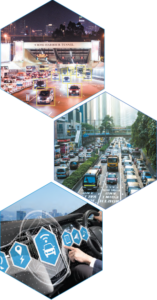
The Government released the Smart City Blueprint for Hong Kong with a vision to build Hong Kong into a world-class smart city. The Blueprint maps out development plans in the next five years, aiming to enhance the effectiveness of city management and improve people's quality of living as well as Hong Kong's attractiveness and sustainability by making use of innovation and technology (I&T).
The Blueprint lists out various strategies and initiatives in six major areas, namely "Smart Mobility", "Smart Living", "Smart Environment", "Smart People", "Smart Government" and "Smart Economy". In the part of Smart Mobility, Hong Kong has designed a comprehensive Strategy and Initiatives, including:
-Integrate existing applications (HKeTransport, HKeRouting and eTraffic News) into an all-in-one mobile app by 2018
-Develop the installation of "in-vehicle units" (IVUs) for allowing motorists to receive real-time traffic information and paying tunnel fees by remote means through the IVUs, without toll booths in the light of the feasibility study to be completed by 2018
-Complete the installation of about 1 200 traffic detectors in all strategic roads to provide real-time traffic information by 2020
-In light of the results of the feasibility study, engage the public to develop a detailed Electronic Road Pricing (ERP) Pilot Scheme in Central and its adjacent areas and its implementation strategy in 2019
-Introduce pilot intelligent traffic signal systems with sensors for pedestrians and vehicles at road junctions starting from 2021
-Adopt an automatic tolling system without toll booths for the new Tseung Kwan O – Lam Tin Tunnel in the light of findings of field trials and subject to the approval of the Legislative Council on the necessary legislative amendments by 2021
-Facilitate trials of autonomous vehicles in West Kowloon Cultural District and other areas as appropriate
-Facilitate public transport operators’ plans in introducing new electronic payment systems for public transport fare collection, having regard to the systems’ reliability, user friendliness and efficiency
-Encourage public transport operators to open up their data
-Pilot the use of technology to deter improper use of loading and unloading bays and illegal parking from 2018
-Explore the use of crowd management system at Kai Tak Sports Park by the management authority to facilitate the monitoring of people and vehicle flows during major events
Source: Text and Photo: Hong Kong Smart City Portal, copyright by Hong Kong Government, https://www.smartcity.gov.hk/develop_plans/mobility/